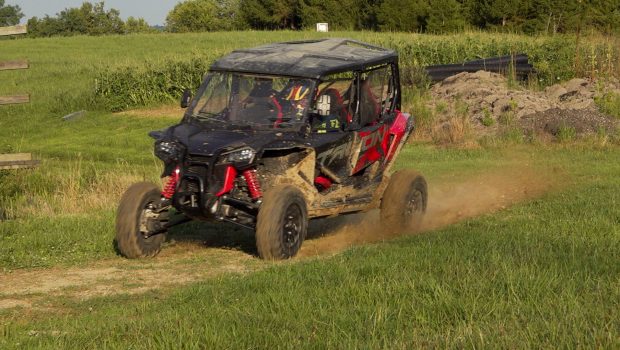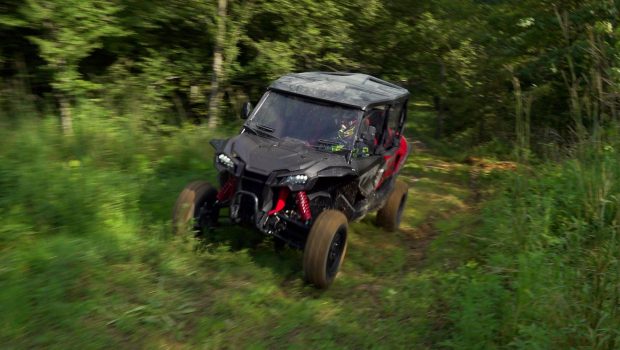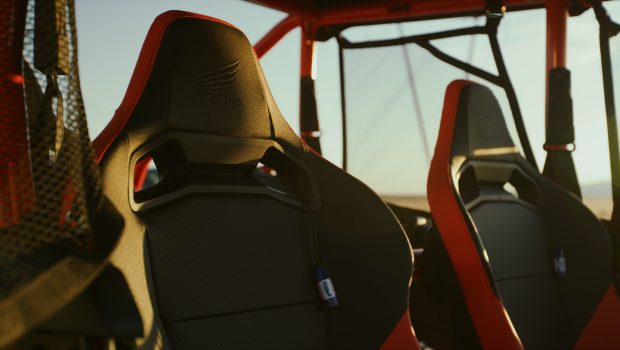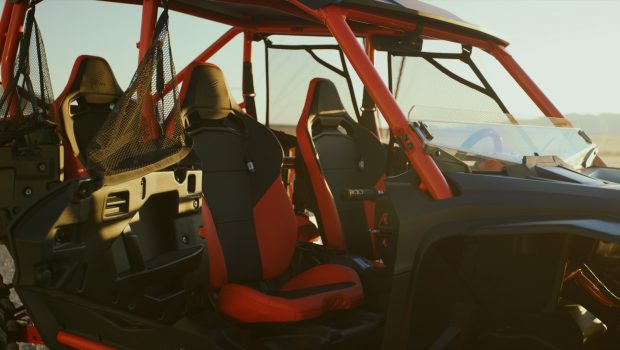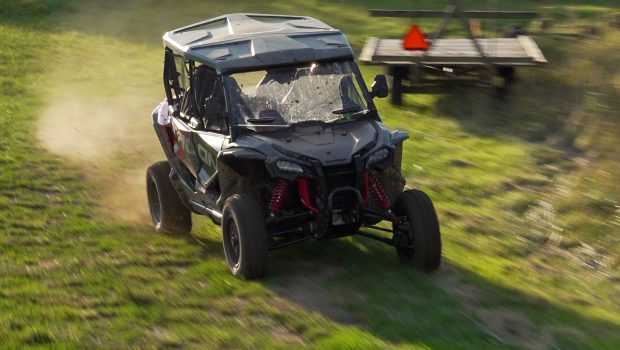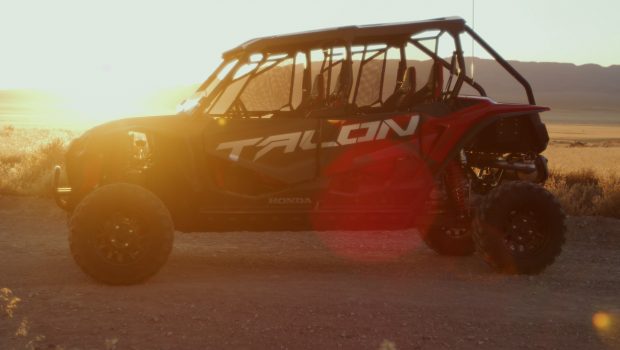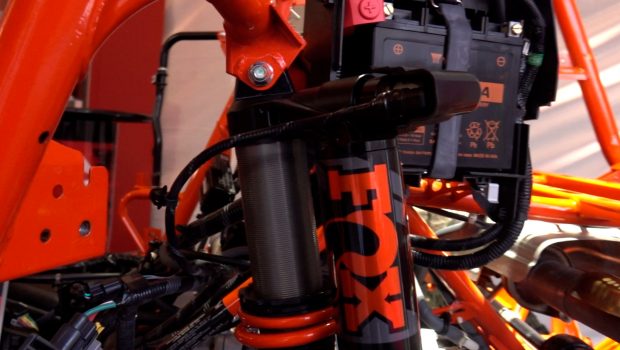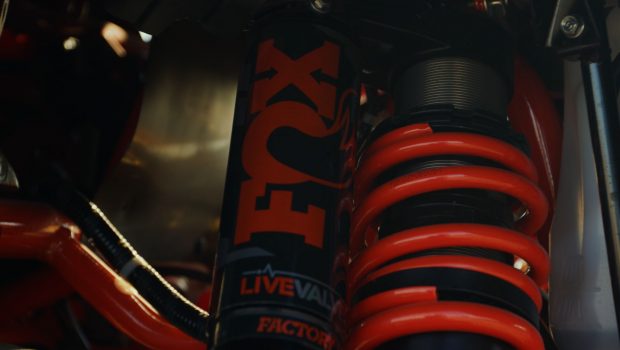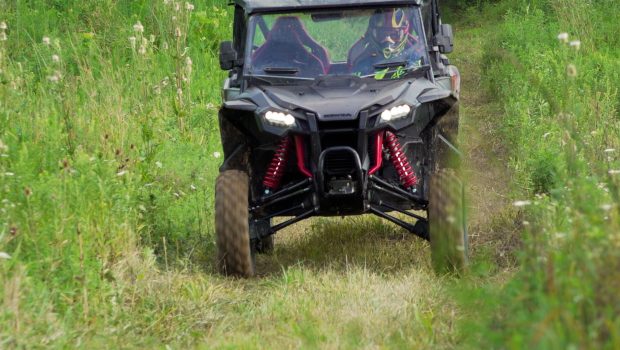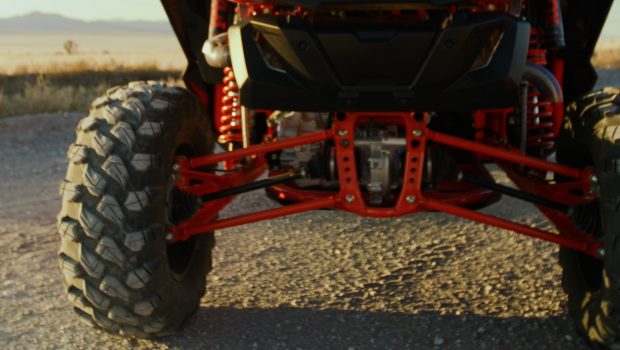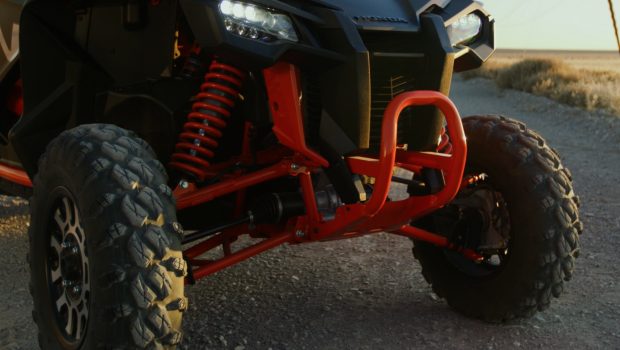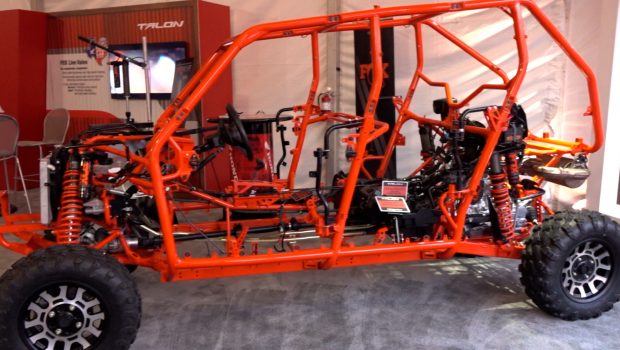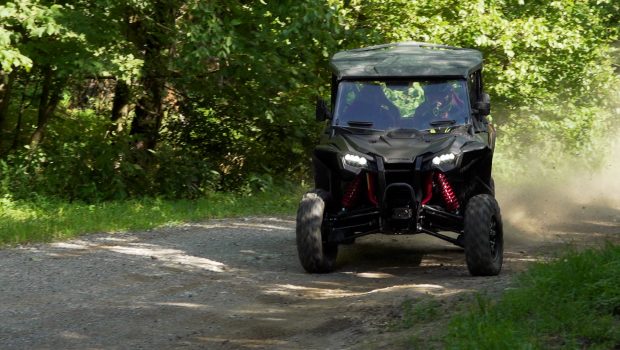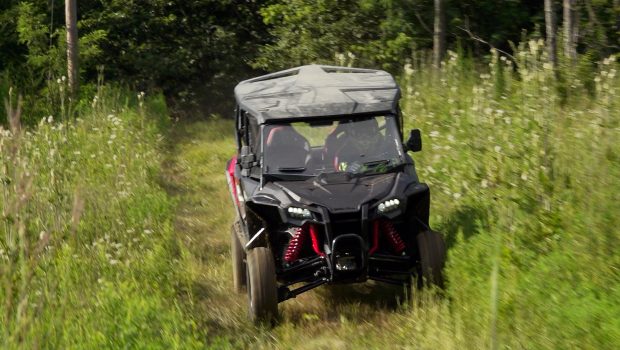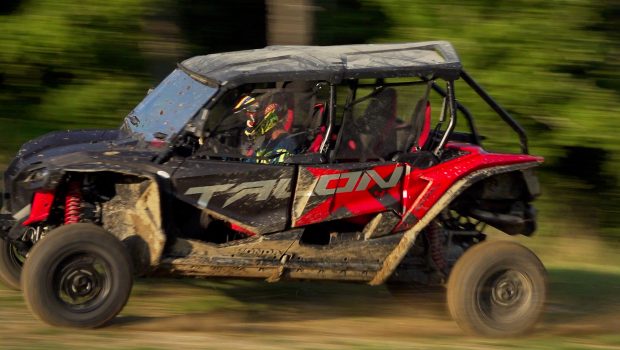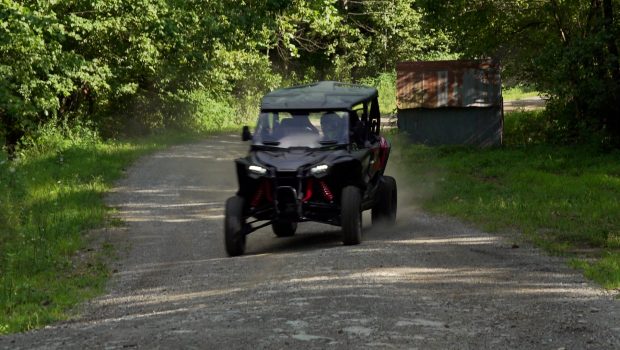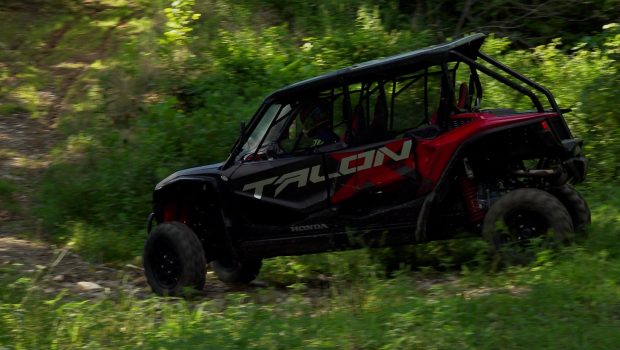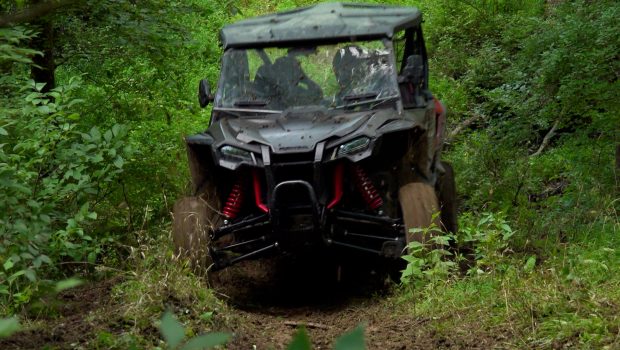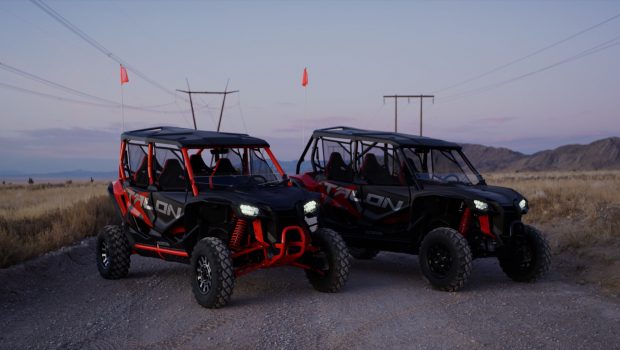Published on May 18th, 2021 | by Joe
2021 Honda Talon 1000 X4 In-Depth Test Review
2021 Honda Talon 1000 X4 Ratings
Summary: Honda’s Talon X-4 checks the box for a lot of potential four-seat buyers. The cabin hosts a comfortable group environment with razor sharp, stable handling, sporty suspension, fun and adequate power for all but the most serious dune drivers. Its only real handicap are the small, short, sidewall tires. It’s more maneuverable than many four-seater sport SXS and it’s the only 4 seat available with a gearbox instead of a CVT, so there are no drive belts to fail. The Talon 1000 X-4 is certainly worth serious consideration as a sporty, family fun machine. Whether the Fox Live Valve shocks and Launch Mode are worth an extra $2,000 is up to you.
3.9
6 Month Test
Following the launch of the highly anticipated 68.4” wide Talon 1000R and 64” width 1000X in 2019, Honda was back at it again just a few months later, releasing two four-seat models, the 2020 Talon 1000X-4 and Talon 1000X-4 Fox Live .
Allen Knowles drove both versions of the TalonX-4 at Honda’s press launch last year and has since done ongoing testing with the X-4 Live Valve on the West Coast. Long-time test driver, Aarom Meyer, purchased the standard X-4 for his growing family in southeast Indiana. Filming with both drivers provided prospective on how the four-seat Talons perform in different terrains nationwide. With the 2021’s having hit the market, here’s our in-depth review of the Honda Talon 1000X-4.
Engine and Transmission
Like the two-seat Talons, the X-4s use a pumped-up version of the engine and transmission found in the Honda’s Pioneer 1000 with a top end borrowed from their Africa twin motorcycle. Producing a modest 104hp, Honda worked to maximize sporty power delivery with an emphasis on strong low to midrange horsepower and torque.
Displacing 999cc with a 10.0:1 compression ratio, the water-cooled, parallel twin features a 270° firing order moving the firing of the pistons closer together to maximize torque and traction. The head features four valves and Honda’s uni-cam design per cylinder, which has proven extremely reliable in their dirt bikes. Electronic Fuel Injection delivers fuel via 46mm throttle bodies. Oil is circulated throughout the engine via dry-sump lubrication, with an oil pan and tank shape that’s designed to help ensure stable lubrication during aggressive driving. A multi-port oil jet lubricates the pistons reducing temperatures. Four automotive style, rubber engine mounts are strategically located to reduce vibration and enhance strength.
The direct gear on gear dive provided by Honda’s Dual-Clutch Transmission is more efficient at transferring power to the ground compared to a CVT transmission. It features a six-speed, dual-range transmission beneficial with varying terrain and tire sizes. The transmission features two auto shift modes, normal and sport, in addition to a manual mode controlled by steering wheel mounted, electronic paddle shifters and a computer controlled clutch. Shift times were cut in half on the Talon compared to the pioneer.
In automatic, normal mode, a computer measures throttle position and input, RPMs, speed, and braking input to determine if you’re driving casually or aggressively, and tries to adjust accordingly, delivering more performance or a quieter ride. Sport mode shifts up and down at a higher RPM allowing the engine to rev higher, longer before shifting. The paddle shifters can be used to override what the automatic mode is doing. After which, the auto mode will return to its regularly scheduled program. The Fox Live Valve version features Launch Mode, allowing you to pull in both paddles, rev the engine to redline, and, essentially, drop the clutch like you would on most manual shift machines.
At the launch of the two-seat Talons, Honda bragged that their drivetrains were designed to withstand repeated jump landings on the gas, the way you’d typically drive an ATV or dirt bike, and we assume that’s been carried over to the X-4s.
While on the move, a switch on the canter dash lets you select between 2WD and Honda’s I-4WD. I-4WD is claimed to offer the traction of a locking front differential without the increase in steering effort and other drawbacks. It uses a limited slip front differential along with a computerized brake control that applies braking to whichever front wheel is slipping, multiplying the force to the wheel that is getting traction.
Honda’s claimed curb weight of 1,735 lbs should put its power to weight ratio pretty well in line with the 110hp, CVT-equipped Polaris RZR XP4 and within 190lbs of the two-seat Talon 1000X.
Adding a good aftermarket full exhaust system like HMF’s Performance series, Titan XL or Titan Quiet, along with a Power Vision Fuel and ignition controller can add an impressive 7.5-9HP and 3.5-4 ft-lbs of torque. If you’re concerned about noise, the Titan Quiet will keep your Honda within 4db of stock at idle.
The gear on gear transmission really makes the most of the available power. Low-end power is decent, allowing you to torque around at slow speeds. The motor’s magic happens in the midrange, providing a broad, usable power spread for spirited rips down the trail. It also makes it easy to hold long drifts in loose turns. Top-end power signs off a bit early, encouraging you to upshift.
Launch mode on the Live Valve edition lets you get off the line a bit more quickly than releasing the brake under power on the standard X4. There’s plenty of power for steep, wooded climbs on wooded and desert trails, although the lack of a turbo will keep you off the steepest dunes, but performs beautifully nearly everywhere else. Power is super manageable in slow speed, technical crawling with the broad, midrange power curve propelling you forward with a decent amount of authority.
The dual-range, six-speed, DCT (dual clutch transmission) further aids the engine in making the most of its broad, usable power. High range works well most of the time with low range tightening up the gear spacing letting you rip around more effectively on tight, twisty trails, while still allowing a high enough top speed for shorter, wide-open sections. Of course, low range is of benefit in super low-speed technical sections with stock or oversize tires.
Top speed, in stock condition, is in the 72-74 MPH range, although Allen has run 32” tires on the Talon raising its top speed to well over 80mph on the GPS.
Honda’s I4WD does well at finding available traction. We ran the Talon with I4WD engaged most of the time to maximize steering accuracy and were still able to drift the Talon in loose terrain with accurate steering. The only real drawbacks we’ve found with the system so far is some heat buildup in the brakes in tight terrain when driving aggressively.
Out West, where the terrain is typically more spaced out, Allen enjoyed the automatic transmission’s normal mode for casual trail cruising. On tighter trails with constant variance in quick up and downhill runs, Aaron found the normal setting in auto to upshift too soon more often than he’d like. Whether you are running in the woods or desert, the automatic shifting sport mode did much better at maintaining proper gear selection, while still not quite as perfect as a CVT, but darn good. Working the paddles brings about the highest level of fun and reward, allowing a skilled driver to get the most out of the engine.
Four-seat Chassis and Suspension
Built on a tough looking tubular steel chassis, the 1000X-4s use the same suspension setup as the 1000X with dual A-Arms front and a three-link trailing arm system out back. Fox Podium 2.0 front and 2.5 rear, QS3 shocks offer spring preload and 3 positions of compression damping adjustment, one for comfortable cruising, general sport riding, and aggressive driving or driving while loaded down. The Fox Live version features Fox Podium 2.5 shocks at both ends featuring spring preload and computer controlled compression damping. A switch in the cockpit lets you select between normal and sport settings. Fox’ Live Valve ECU examines vehicle speed, engine RPM, throttle input, steering, braking, and a five-axis inertia measuring unit every 5 milliseconds or 200 times per second. It then uses that data to continuously fine-tune each shock’s compression damping independently up to 16 times per second, trying to deliver the plushest ride possible without bottoming harshly on big hits, as well as, fighting pitching and rolling. There’s 14.6” of wheel travel front and 15.1 out back, a bit on the short side for the 64” class. Both Talon X-4s feature electric power steering.
28×9-15 front and 28×11-15 rear Maxxis tires are the same ones used on the Talon R and X models, and come wrapped around aluminum wheels. The 64” wide Talon X-4 has a 116.4” wheelbase, one of the shortest in the class. 12.8” of ground clearance is respectable. A claimed overall height of 78.5” is on the high side.
The ride is reasonably plush over small, square edged hits from roots and rocks, which keeps the wear factor on riders down on long rides. However, Honda seems to have gone just a touch too far to the stiff side leaving plenty of bottoming resistance and, perhaps, a bit too much. Mid-size and larger hits are a bit harsh, and softening the suspension up may result in more bottoming, but doesn’t eliminate the bigger hit harshness.
As it turns out, some of this can be attributed to the stock tire and wheel setup. Taller tires roll over holes better, and an increased sidewall height allows more flex, further damping harsh hits. A slightly heavier tire and wheel setup only seems to help the suspensions. Add bigger tires to the Talon X4 before you start swapping out springs or valving in your shocks; the suspension seems to work much better.
The X4 is an accurate steering SXS, made even more accurate by taking advantage of I4WD to help pull you through turns. We feel most drivers will appreciate the super flat cornering manners of the Fox Live Valve suspension making body roll virtually disappear. However, if accurate steering matters most, the very mild front-end dive and roll of the standard X4 allow you to set the front end and get the outside tire biting harder in turns improving cornering traction. The faster you are, the chances are the more likely you’ll prefer the standard Fox shocks found on the base model X4. Aaron had no complaints with stability on his standard Talon X4.
Power steering was nearly flawless although Aaron did complain of a small amount of unwanted push back through the steering wheel when counter steering in power slides. We attribute this to braking and power transfer forces on the front wheels from the I4WD.
In rolling fields, or whooped out desert, the Talon makes good use of its available suspension travel and four-seat wheelbase offering good, straight line stability at speed.
Brakes
Braking power is provided by four-wheel, hydraulic disc brakes featuring 250mm rotors at all four corners with dual piston calipers front and single piston calipers out back. In 2WD, Honda’s unique electronic brake force distribution system is designed to optimize brake force front to rear, under changing load conditions to maximize braking traction and control. Honda’s push button, hill start assist applies the brakes for a few seconds, allowing you to take your foot off the brake and hit the gas for single-foot driving.
Driving out West in the high-speed desert ,Allen is no stranger to hard braking into corners with the Talon offering plenty of stopping power and feel. With long runs between turns, hear and fade aren’t an issue. Aaron, on the other hand, is also a very aggressive driver. He complained about the brakes heating up and fading during our testing. I4WD utilizes the brakes to modulate front end traction, a contributing factor no matter where you drive, but the shorter runs between turns in the woods give less opportunity for the brakes to cool off. We’d recommend switching to a higher quality brake fluid like Motul to help keep the brakes running cooler.
Interior and Storage
You enter the Talon through doors with lower cut-outs front and rear. Door nets come standard and offer an added level of safety. To enhance the experience for all four occupants, Honda mounted the digital display in the center dash. A tilt adjustable steering wheel and slide adjustable seat are found on the driver’s side with a t-handle grab bar on the passenger side. It offers infinite adjustment and a more secure feeling than other designs thanks to a clamp that holds it tightly in place.
High-back, bolstered seats feature pass-through for easy harness installation. The rear seats are nearly 3” higher and 2” closer for an improved viewing experience. A well-designed roof is standard equipment.
In cabin, there’s a passenger side glove box. Oversize cup holders are available front and rear. Out back, the bed can haul along an additional 299 lbs of cargo.
The doors are high-quality, but all agree that full lower doors would be better. Space wise, the cockpit offers similar space to other machines in the class with Allen’s 6’4” frame pushing the limits of front seat accommodations. Aaron felt the sight line was a bit high over the hood, but not a deal breaker. Those 6’ and under won’t feel too claustrophobic in the back seats with good sight lines and ample hand holds. Overall comfort and quality are on the high-end as you would expect from Honda.
Conclusion
Honda’s Talon X-4 checks the box for a lot of potential four-seat buyers. The cabin hosts a comfortable group environment with razor sharp, stable handling, sporty suspension, fun and adequate power for all but the most serious dune drivers. Its only real handicap are the small, short, sidewall tires. It’s more maneuverable than many four-seater sport SXS and it’s the only 4 seat available with a gearbox instead of a CVT, so there are no drive belts to fail. The Talon 1000 X-4 is certainly worth serious consideration as a sporty, family fun machine. Whether the Fox Live Valve shocks and Launch Mode are worth an extra $2,000 is up to you.

